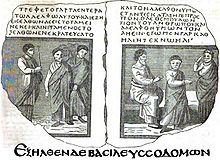- Cotton Genesis
-
The Cotton Genesis (London, British Library, MS Cotton Otho B VI) is a 4th- or 5th-century Greek Illuminated manuscript copy of the Book of Genesis.[1] It was a luxury manuscript with many miniatures. It is one of the oldest illustrated biblical codices to survive to the modern period. Most of the manuscript was destroyed in the Cotton library fire in 1731, leaving only eighteen charred, shrunken scraps of vellum. From the remnants, the manuscript appears to have been more than 440 pages with approximately 340-360 illustrations that were framed and inserted into the text column. Many miniatures were also copied in the 17th century and are now in the BnF in Paris (Ms. fr. 9530).
Joseph with his brethren in his own house, on their return into Egypt; illustration to Genesis 43:30-31; from the facsimile Horne's edition (1852)
Contents
Description
The manuscript contains the text of the Book of Genesis on 35 parchment leaves (size about 27 x 22 cm), with numerous lacunae.[2][3] The original codex contained 165 leaves, in the quarto size. It is written in uncial letters, in one column per page, in 27-30 letters per line. The nomina sacra usually are written in an abbreviated forms: ΚΣ, ΚΝ, ΘΣ, ΘΝ, for κυριος, κυριον, θεος, θεον. It contains some illustrations (e.g. Joseph with his brethren in his own house, on their return into Egypt).[4]
The miniatures were executed in a late antique style, retaining classical illusionistic qualities. Herbert Kessler and Kurt Weitzmann argue that the manuscript was produced in Alexandria, as it exhibits stylistic similarities to other Alexandrian works such as the Charioteer Papyrus.
History of the codex
According to Tischendorf it was written in the 5th century.[5] The Cotton Genesis appears to have been used in the 1220s as the basis for the design of 110 mosaic panels in the atrium of St Mark's Basilica in Venice, presumably after it was brought to Venice following the sack of Constantinople by the Fourth Crusade in 1204. The manuscript arrived in England, and was acquired by Sir Robert Cotton in the 17th century. His collection passed to the British Museum.
It was brought from Philippi by two Greek bishops, who presented it to King Henry VIII, whom they informed that tradition reported it to have been the identical copy which had belonged to Origen.[4]
In 1731, while the codex was at Ashburnham House with the rest of the collection, it was reduced by fire to a heap of charred and shrivelled leaves.[1] Afterwards the rest of the codex was divided in two parts. One part of it (29 folios) was moved to the British Museum, another to the Bodleian Library.
Until the middle of the 19th century it was thought to be the oldest manuscript of the Septuagint. According to Thomas Hartwell Horne it was not only the most ancient but the most correct manuscript that is extant.[6] According to Swete the manuscript even before the fire had been imperfect.[3]
Most of the London fragments of the codex were deciphered and published by Constantin von Tischendorf in 1857;[7] the rest of the codex with the Bristol fragments were deciphered by F. W. Gotch in 1881.[8]
See also
- Vienna Genesis – another illuminated Greek manuscript of the Book of Genesis
- Early Christian art and architecture
References
- ^ a b Würthwein Ernst (1988). Der Text des Alten Testaments, Stuttgart: Deutsche Bibelgesellschaft, p. 85.
- ^ Alfred Rahlfs, Verzeichnis der griechischen Handschriften des Alten Testaments, für das Septuaginta-Unternehmen, Göttingen 1914, pp. 107-108.
- ^ a b Swete, Henry Barclay (1902). An Introduction to the Old Testament in Greek. Cambridge. pp. 109–110.
- ^ a b Thomas Hartwell Horne, An introduction to the critical study of the Holy Scriptures (New York 1852), Volume 1, p. 226.
- ^ Tischendorf, Monumenta sacra inedita (Leipzig 1857), XIII.
- ^ Th. H. Horne, An Introduction to the Critical Study and Knowledge if the Holy Scriptures (New York 1852), p. 236
- ^ Tischendorf, Monumenta sacra inedita (Leipzig 1857), nov. coll. II.
- ^ F. W. Gotch, Supplement to Tischendorf's Reliquiae cod. Cotton. (London 1881)
Further reading
- Calkins, Robert G. Illuminated Books of the Middle Ages. Ithaca, New York: Cornell University Press, 1983.
- Alfred Rahlfs, Verzeichnis der griechischen Handschriften des Alten Testaments, für das Septuaginta-Unternehmen, Göttingen 1914, p. 107-108.
- Constantin von Tischendorf, Monumenta sacra inedita (Leipzig 1857), XIII, XXII-XXXVI.
- Weitzmann, Kurt. Late Antique and Early Christin Book Illumination. New York: George Braziller, 1977.
- Weitzmann, Kurt and Herbert L. Kessler. The Cotton Genesis: British Library, Codex Cotton Otho B VI. Princeton: Princeton University Press, 1986.
External links
Categories:- Illuminated biblical manuscripts
- 6th-century biblical manuscripts
- Septuaginta manuscripts
- Cotton Library
Wikimedia Foundation. 2010.


